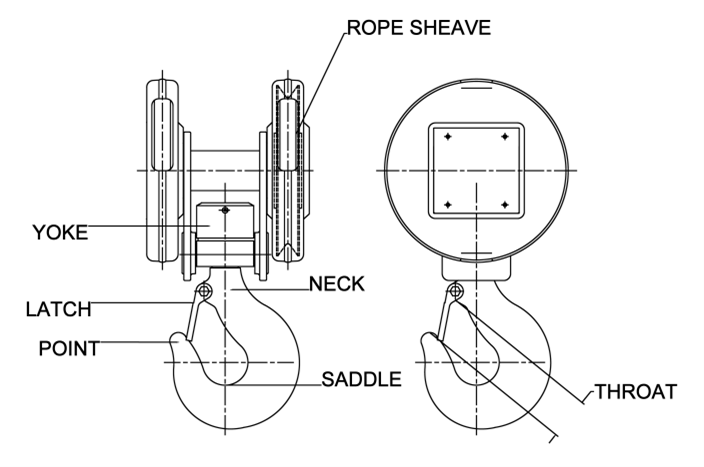Wire Rope
Product Glossary
Use our Electric Wire Rope Product Glossary to enhance your understanding of the terminology associated with our electric wire rope products.
Electric Wire Rope Product Glossary
- Block Operated Limit Switch: A limit switch that prevents operation in the up direction when contacted by the hook block. Operates independently of drum rotation.
- Bumpers: A device for reducing horizontal impact when a moving crane or trolley reaches the end of its permitted travel, or when two moving cranes or trolleys come into contact. This device may be attached to the bridge, trolley, or runway stop. Also referred to as buffers.
- Capacity: The maximum rated load a hoist is designed to lift. Also referred to as Working Load Limit (WLL) or Safe Working Load (SWL).
- Count Hour Meter: A device that records motor starts, running time and usage history by instant digital display. Integral to VFD on dual speed models.
- Deck/Base Mount: A stationary type of mounting where the hoist is mounted to the top side of a horizontal supporting surface.
- Drop Stops: A means to prevent an end truck or trolley from disengaging the beam or rail in the event of an axle or wheel failure.
- Emergency Stop (E-Stop): A red push button that stops all hoist and trolley function when pushed.
- Festooning: A method for supplying power and control. This method utilizes loops of cable suspended by a guide wire or enclosed track that traverses along with the hoist and trolley.
- Flange, Flat: A beam that has flat top and bottom flanges. Also referred to as “W” beams or “H” beams.

- Flange, Tapered: A beam that has tapered top and bottom flanges. Also referred to as “S” beams.

- Headroom: On drawings in this catalog, headroom is indicated by dimension ‘C’ or ‘E’. It is measured when the hoist’s bottom hook is in its uppermost position. For a hoist suspended from a trolley, headroom is the distance from the bottom of the beam to the saddle of the bottom hook. Headroom is the distance from supporting surface on base and deck-mounted hoists to the saddle of the bottom hook.
- Hoist Duty Service Classification Rating: A classification of hoist usage and service based on hours of operation and load. See specific product catalog for details on duty service classification.
- Hook Parts:

- Infinitely Variable, 2-Step: An option available on some VFD controlled hoists and trolleys. 2 step infinitely variable allows the user to accelerate, then hold any speed between low and high.
- Infinitely Variable, 3-Step: Similar to 2-Step Infinitely Variable but also includes deceleration between high and low speed.
- Lift: The maximum vertical distance the bottom hook can travel.
- Minimum Radius for Curve: Defines the sharpest curve of a beam on which the trolley can traverse.
- Motor Brake (Holding Brake): A friction brake for a hoist or trolley which is automatically applied and prevents motion when power is off.
- National Electrical Manufacturers Association (NEMA) Rating: A rating to show the application or environmental conditions enclosures are designed to protect against.
- Overload Limiter: A means to prevent the hoist from lifting damaging loads.
- Pendant: This is the hand held push button control device that is attached to the hoist or trolley. The number of buttons can vary dependently upon its uses.
- Pendant Drop: On drawings in this catalog, pendant drop is dimension ‘L’ for hoists and trolleys. Pendant drop is a measure of the distance the pendant hangs. For a hoist, it is the distance the pendant hangs from the hoist’s top hook. For a hoist suspended from a trolley, it is the distance the pendant hangs from the bottom of the beam that the trolley rides on. When pendant is specified as “standard to lift”, the bottom of the pendant will hang approximately 4’ above the bottom hook in its lowest position.
Deck Mount Hoist / Trolley Suspended Hoist

- Plug and Play: A crane integration wiring method that terminates all crane wires and trolley hoist festooning via externally mounted plugs on the bridge control panel.
- Power, 3-Phase: A power supply consisting of 3 separate phases of AC Power and a ground, commonly used in industrial applications to power large motors and heavy loads. Common voltages include 208, 230, and 460.
- Reaction Forces: The maximum vertical force (without impact) produced on any trolley wheel through the sum of the rated load and the trolley/hoist weight.
- Reeving: The number of lines of wire rope between the hoist body and bottom hook. Also referred to as “falls” or “parts”.
- Rope Drum: A grooved cylindrical member around which the rope is wound for lifting and lowering the load.
- Rope Guide: A spring tension device that guides the wire rope on and off the drum.
- Rope Sheave (Pulley): Rope sheaves can be located in the hoist body or the lower hook block and guides the wire rope as it reeves its way through the hook yoke(s).
- Standard, ASME B30.16: “Safety Standard – Overhead Hoists (Underhung).”
- Standard, ASME B30.17: “Safety Standard – Cranes and Monorails (With Underhung Trolley or Bridge).”
- Standard, UL1340: “Standard for Safety, Hoists”.
- Test Load: The load applied to the hoist to confirm proper operation in accordance with ASME B30.16 test requirements.
- Thermal Protection: A method to protect electric motors from damage due to over-current or overheating.
- Upper/Lower Limit Switches: An electro-mechanical device that prevents the lower hook from exceeding its’ limits of travel.
- Variable Frequency Drive (VFD): Also known as an inverter. An electronic device that controls the voltage and frequency to an electric motor to control speed and/or torque.
- Wire Rope: A stranded steel cable used for lifting and lowering the load.